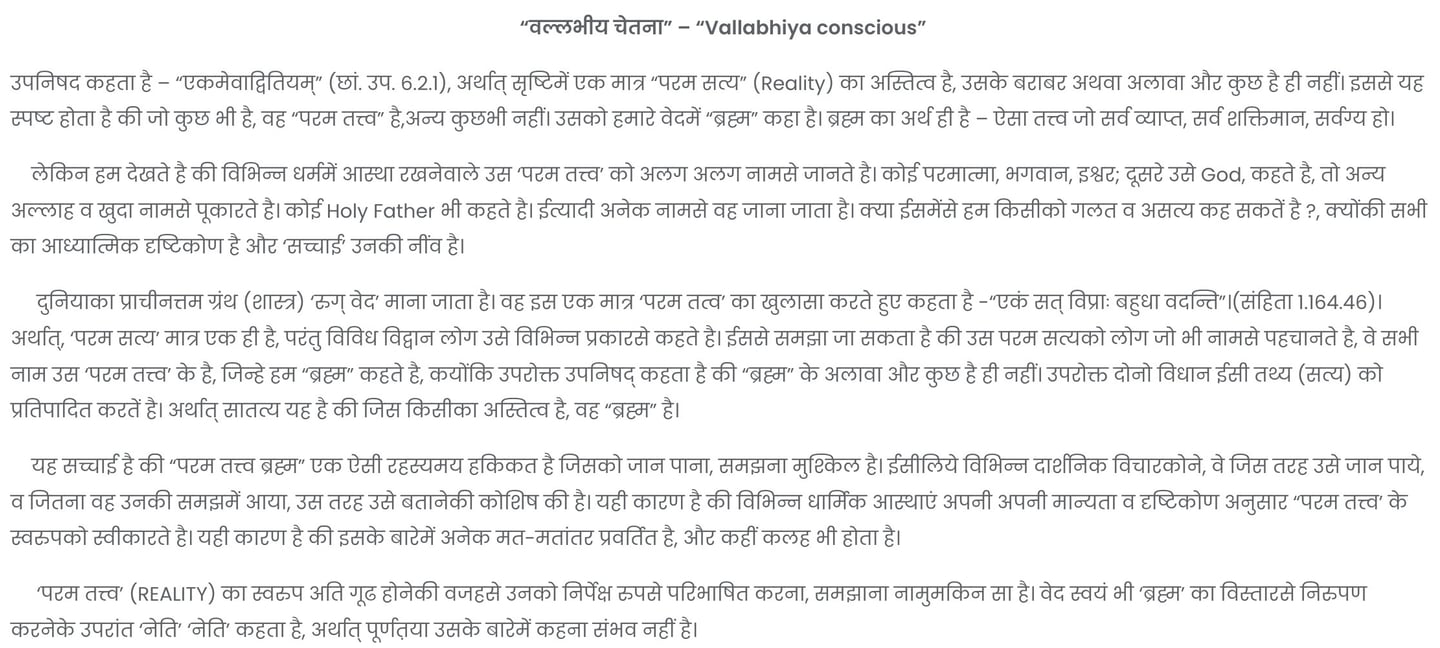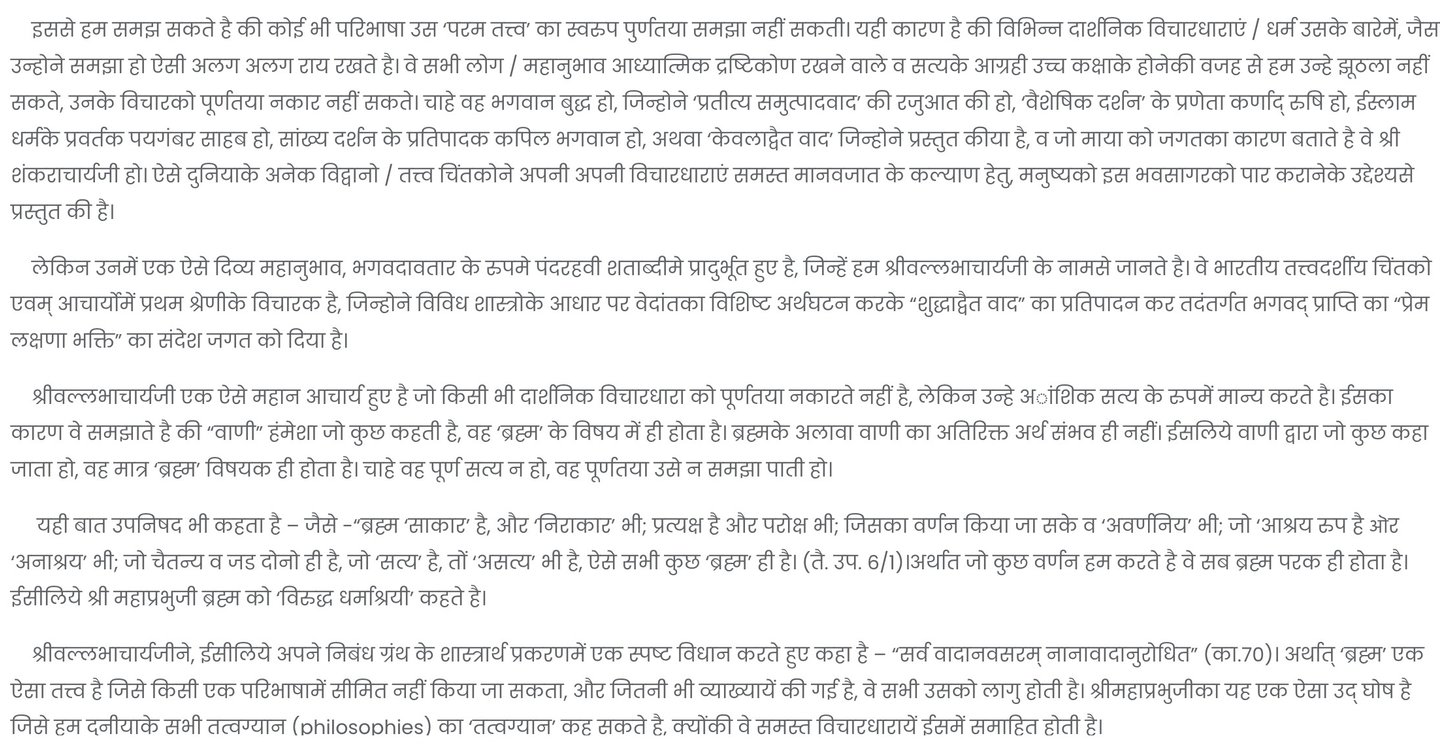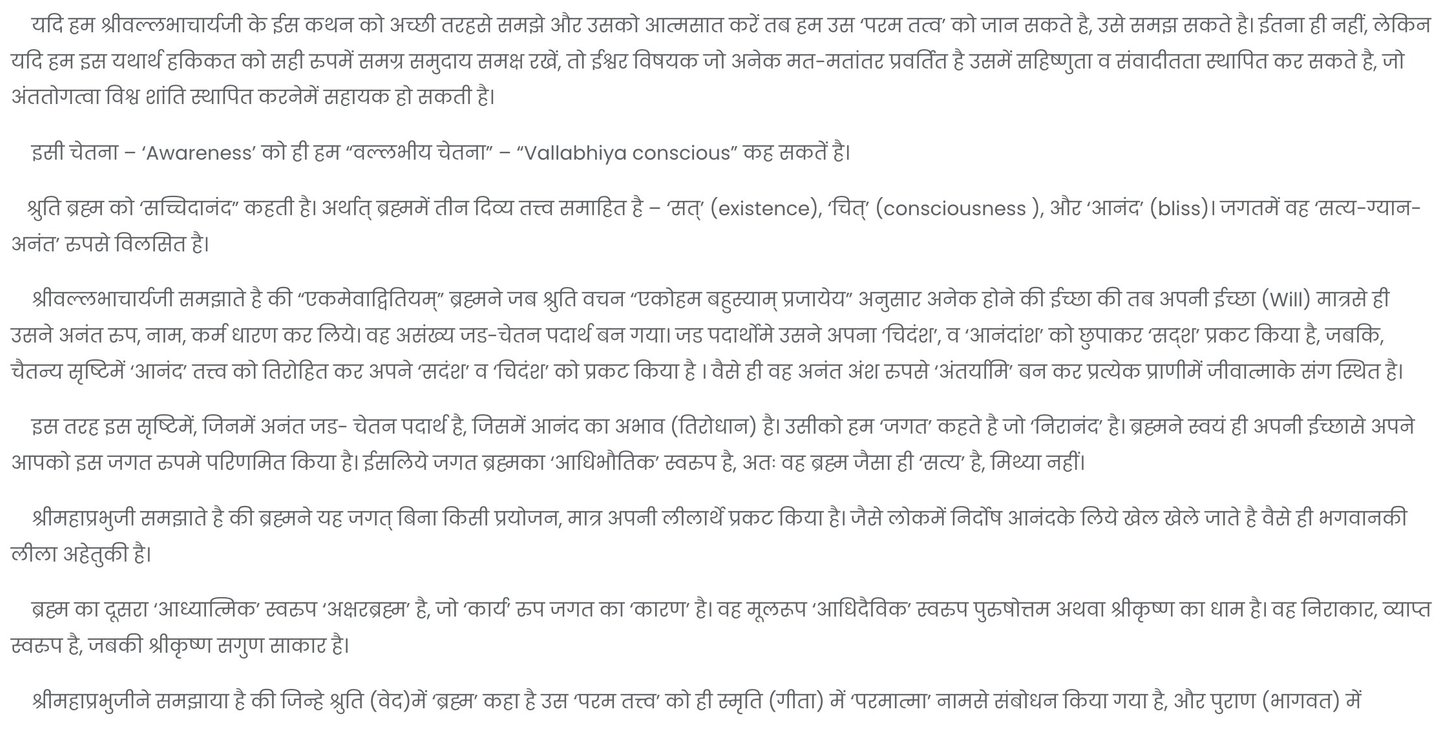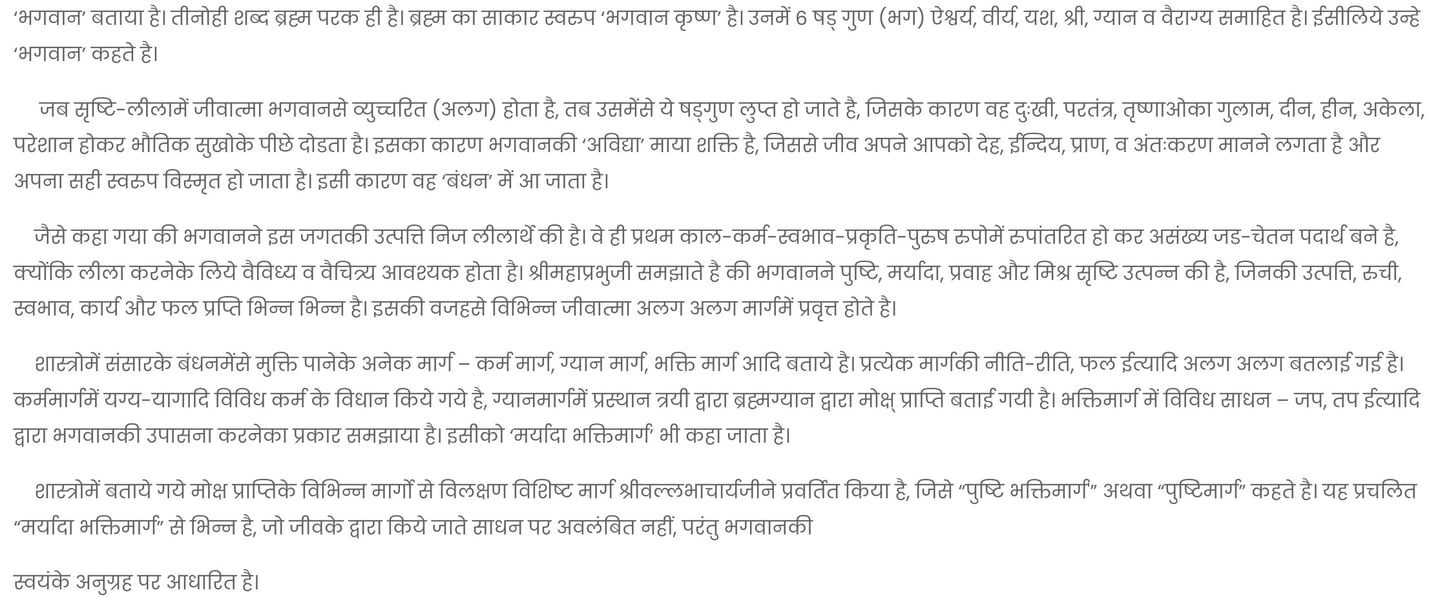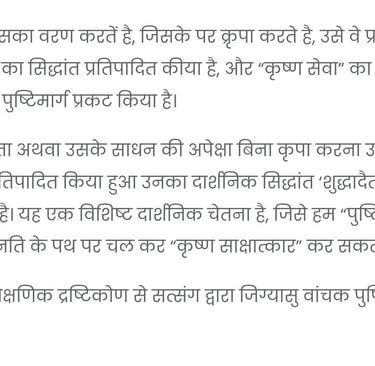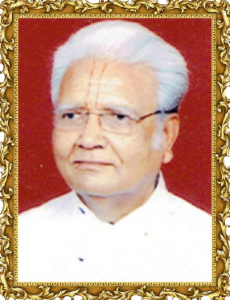Upanishad says – “The REALITY is one, Only One, without second”. ‘EKAMEVADVITIYAM”. (chha. up. 6.2.1). This implies that nothing else exists except ‘REALITY’, which Veda denotes by the word “BRAHMA”. It signifies that the “Reality” is Omnipresent, Omnipotent, Omniscient. However, various religious faiths designate that “Reality” by different names. Some call it “Parmatma”, “Bhagwan” or “Ishvar”, others call it “God”. Yet another by name “Allah” or “Khuda”. Many know it as “Holy Father” and so on. Yet, none of them should be wrong as all these are spiritual beliefs, inspired by truthfulness.
Our ancient scriptures ‘Rig Ved’ explains the phenomenon of diverse views of an “Only Reality” thus – “EKAM SAT VIPRAHA BAHUDHA VADANTI” (Rig Ved – 1.164.46), meaning – ‘The Reality is one only, but is designated differently by various eminent scholars’. Various names attributed by different religious faiths indicate One and same Reality Only. Thus when we consider both these statements, they corroborate and explain the “TRUTH”.
That TRUTH, the REALITY, is “BRAHMA”. It is, in fact, a unique entity, a mysterious phenomenon, about which various religious faiths or philosophical thoughts have tried to describe according to what they have been able to comprehend or understand. As such, it is a matter of fact that diverse views for the “Reality” persist amongst different religious orientations or their scholars, which sometimes give rise to disputes and quarrels, or even animosity amongst the followers thereof.
It appears that, because of the complex nature of the ‘REALITY’, one cannot define or explain it in absolute terms. Even vedas which have elaborately explained the nature of ‘BRAHMA’, in various aspects, it eventually says – ‘Neti, Neti’, meaning not “This Much”, i.e. is still more than what is described. It is therefore, obvious that none can interpret the “Reality” fully or wholly. Yet, we can see that each of the versions by various religious faiths or philosophical thoughts have their reasoning, and as such, one cannot discard them totally, since those who have explained the ‘REALITY’, as per their own perceptions are great spiritual luminaries having high moral character. May they be Bhagwan Buddha, propounding ‘Pratitya Samutpadvad’, Rushi Kanad, the originator of ‘Vaisheshik Darshan’, Mohd. Paygambar, the profet who preached “Islam”, Kapil Muni, who explained ‘Sankhya Darshan’, Sri Shankaracharya an eminent Acharya, the propounder of ‘Kevaladvait’ philosophy, who claimed the world phenomenon as the creation of Maya, and many similar scholars, philosophers and great personalities, the world over, who have contributed to enrich the philosophical and religious concepts and put forth their doctrines aiming at the cause of sublimation of the mankind and emancipation ultimately, serving the humanity at large.
But, there has been one Godly Personality, a ‘Bhagavadavtar’, SRI VALLABHACHARYAJI, who is one of the foremost Indian philosophers and Acharyas, taking the rank amongst the first class thinkers, who has expounded the philosophy of the non-dualistic Monism characterised as the “Pure Non-Dualism”(SHUDDHAVAIT) without interference of ‘Maya’. He is the first exponent of no-dualistic philosophy of Monotheism and the doctrine of “GRACE” religiously (PUSHTIMARGA).
He is the one great Acharya who does not discard any of the philosophical points of view in toto, i.e. summarily, but accepts them as partial ‘Truths’ for the reason, as he explains, that the ‘Vaani’ (speech) always describes or speaks about ‘Brahma’ only and nothing else. As such, whatever is being said, must be ascribed to Brahma alone, though it may not be the whole truth or it may not explain it fully. This fact is endorsed by Upanishad where it says that “Brahma has become one, having a form and formless too, perceptible and indirect, definable and one which cannot be described, having substratum and without any base also, conscious and unconscious too, real as well as false, all such HE is” (Taittiriya Up. 6/1). Brahma, “The Reality” is having such contradicting attributes (Virruddha-Dharmasya). Sri Vallabhacharyaji has, therefore, made a very significant statement in one of his ‘granthas’ (literary works). He says – “SARVA VADANAVSARAM, NANAVADA NURODHIT”. (Nibandh 1/70), meaning that Brahma is such an entity which cannot be confined into any one definition, yet, it encompasses all the versions or interpretations given by various philosophical doctrines.
This, in fact, is a very bold and significant statement which can be termed as ‘Philosophy of all the philosophies’ of the world, since it covers all the interpretations put forth by the various divine personalities and great scholars of the world, in respect of the “REALITY”.
We can understand that this is a unique concept or an awareness proclaimed by the great divine God-head Sri Vallabhacharyaji, which, if comprehended in proper perspective, can enable a devotee to develop ‘Sarvvotam’ bhav’ and realize God. Not only that, but if such consciousness promoted or propagated conscientiously, it can help to harmonise relationship amongst people at large globally and can contribute to a great extent, to establish peace in the world.
We may designate such a Philosophical Awareness as ‘VALLABHIYA CONSCIOUSNESS”.
Shruti defines Brahma as “SACHCHIDANAND”, an embodiment of three divine elements viz., ‘SAT’-(Existence), ‘CHIT’-(Consciousness), and ‘ANAND’-(Bliss). HE prevails in the Universe as ‘SATYAM-JANANM-ANANTAM’, i.e. ‘Sat evolved into ‘Satyam’, ‘Chit’ evolved into ‘Jnanam’, and ‘Bliss’ into ‘Anantam’, Shri Vallabhacharyaji explains that when “Ekamevadvitiyam” Brahma desired to be many, HE acquired many forms having different names, by His WILL alone, and became innumerable animated and inanimated objects by concealing His Anand (Bliss) element and manifesting only ‘Sat’-amsh, and ‘Chit’-amsh, as well as ‘Anand’-amsh and manifesting only ‘Sat-amsh in all inanimated objects. However, ‘Anant’ (infinite) ‘Anand’-amsh, called ‘Antaryamins’ dwells in all animated objects (Praani Srushti) alongwith ‘Chit-amsh’ called ‘Jivatman’ (Soul).
Thus, the CREATION consists of infinite objects, both animate and inanimate, which are devoid of ‘ANAND’ element (rather concealed) which is known as ‘SRUSHTI’, -the Universe or JAGAT, as we call it. As such “Jagat” is an “Adhibhautik Aspect” of Brahma, who created it Himself, out of His Promordialform (Mul Svarup), i.e. His Adhibhautik Aspect (PURSHOTTAM or SRI KRUSHNA), hence it is as real as Brahma Himself.
Brahma, in His personal form “BHAGWAN”, identified as SHRI KRUSHNA in Bhagwat, has six divine attributes viz. Aishvarya (Greatness), Virya (Potency), Yash (Glory), Shri (Beauty), Gnan (Knowledge)and Vairagya (Detachment). When a jivatman gets detached from Brahma during the process of creation, it loses those divine attributes, due to which it (soul) becomes miserable, dependant, slave of his passions/desires, humble and lonely, unhappy and gets attached to worldly pleasures. After separation from Brahma, the soul is subjected to the influence of nescience (avidya), which ultimately results into bondage and sufferings.
One may raise a question as to what is the purpose of the Creation? Shri Vallabhacharyaji explains this in “Anubhasya”, his important literary work. He says “Na prayojanatvat”. There is no specific purpose but it is Brahma’s “LILA”, i.e. an innocent play like one indulged by children. An overflow of “Anand” is called “Lila”. It requires diversity and pecularity. We find both these ingredients in the universe. The enormous activities going on in the “Jagat” is Brahma’s Lila”, for which He has acquired five forms viz. “Prakruti” (inert matter), “Purush” (consciousness), “Kaal” (time), “Karma” (Kinetic energy) and “Svabhav” (nature). Due to this we find innumerable variety of objects and various species in the universe.
Shri Vallabhacharyaji, on the basis of scriptural statements, explains that variety of jivatmans are evolved out of Brahma. He identifies the types of ‘jivatmans’ (individual selves) as Pushti, Maryada and Pravahi, depending on their origin, nature, interest, pursuits and ultimate destiny. There are various gradations of the jivatman which depends on the contents of particular aspects, viz. Pushti-Maryada, Pravah-Pushti, ShuddhaPushti etc., which indicates their inclinations and orientations towards the path one chooses for spiritual journey and ultimate deliverance.
Our scriptures have shown various paths for emancipation viz. ‘Karma-marga’ (Path of Action), ‘Gnan-marga’ (Path of Knowledge) and “Bhakti-marga” (Path of Devotion). Each of these paths has pros and cons, and they lead to obtaining different, rewards (fal), depending on the desire of the person who selects one or the other path to achieve his goal. However, Shri Vallabhacharyaji has given a unique mode to the traditional ‘Bhakti-marg’, and termed it as ‘PUSHTI BHAKTI MARG’, or simply ‘PUSHTI MARG’, the clue he took from the statement of Upanishad – “YAME VAISHA VRUNUTE, TEH LABHYA” meaning, He (God) could be realized by one whom HE chooses. This indicates an element of “GRACE” (Krupa). He also drew inspirations from the “Vraj Gopijans” who had realised “Shri Krishna” by pleasing HIM with their pure unadulterated “LOVE” for HIM. This is quite different from scriptural Bhakti marga, normally known as ‘Maryada Bhakti marga’, that relies on various means (Sadhan) to be adopted by a devotee, to perform “Bhakti”. Normally, it is called “Upasana Marga” also.
“Pushtimarg”, enunciated by Shri Vallabhacharyaji, has bearing on the “Pushti”, i.e. “GRACE” of the God, which is HIS inherent and independent attribute, which He adopts at His WILL, and showers on a devotee whom He chooses, for, He is totally independent and omnipotent. He may select a devotee to reveal Himself before one, irrespective of one’s virtues or efforts. This is a unique philosophical approach adopted and propagated by Shri Vallabhacharyaji which has sound bearing on various aupanishadik verses and the theological explanations given in “BHAGWAD GITA” and “SHRIMAD BAHGWAT”. Pushtimarg has the firm footings of philosophical thoughts of “Pure Non-Dualistic Monoism” (Shuddhadvait-vad) propounded by Shri Vallabhacharyaji which is explained herein before. It is the concept of his philosophical consciousness, which when coined with the practical path of emancipation of God-Realization, can be termed as “PUSHTI-CHETNA“, an awareness which induces and inspires the devotee to pursue or follow this unique path – “Pusti Bhakti marg”, i.e. “Pusti marg”, for the sublimation of the life, and realizing “SHRI KRUSHNA”, the ultimate goal of pusti jiva’s endeavour.
Eventually, we should elaborate various aspects of both “TATTVA DARSHAN” (Philosophy) and “DHARMA DARSHAN” (Theological approach) of Shri Vallabhacharyaji on the basis of his principles as contained in his various literary works.
“JAY SHRIKRUSHNA”
PUSHTI CHINTAN – VALLABHIYA CONSCIOUSNESS

